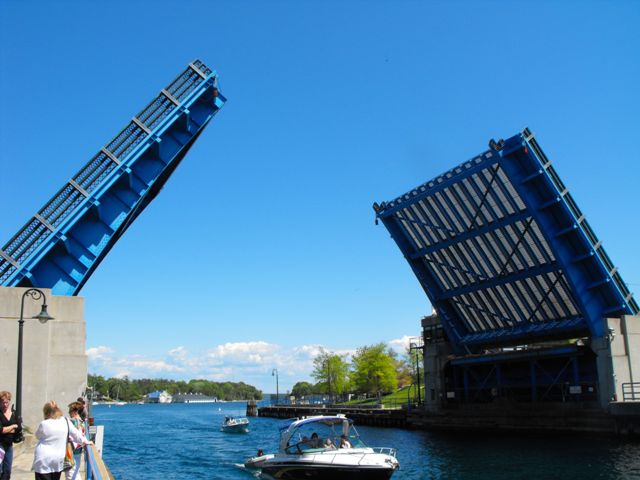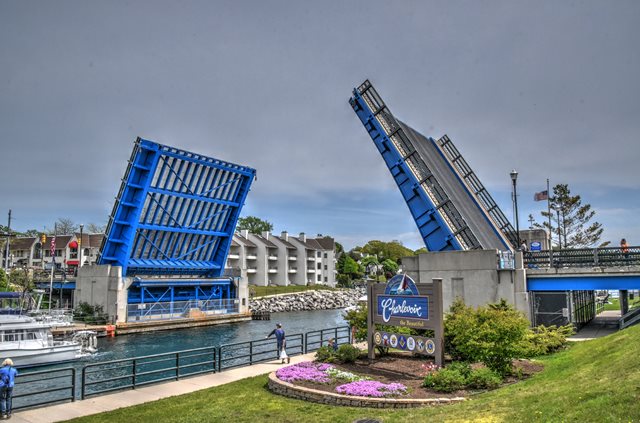We Recommend:
Bach Steel - Experts at historic truss bridge restoration.
Charlevoix Bridge

Primary Photographer(s): Nathan Holth
Bridge Documented: June 12, 2009, June 7, 2010, and June 3, 2017
Charlevoix: Charlevoix County, Michigan: United States
Metal Variable Depth Deck Girder, Movable: Double Leaf Bascule (Rolling Lift) and Approach Spans: Metal Stringer (Multi-Beam), Fixed
1948 By Builder/Contractor: Mount Vernon Bridge Company of Mount Vernon, Ohio and L. W. Lamb Company of Jackson, Michigan and Engineer/Design: Hazelet and Erdal of Chicago, Illinois
1992
111.0 Feet (33.8 Meters)
222.8 Feet (67.9 Meters)
44 Feet (13.41 Meters)
1 Main Span(s) and 2 Approach Span(s)
15115012000B010

View Information About HSR Ratings
Bridge Documentation
This bridge is a traditional movable bridge in Michigan: a deck plate girder bascule bridge that still operates frequently, usually for pleasure craft. Although the bridge superstructure retains good historic integrity, like most Michigan bascule bridges, the original railings have been destroyed. However, interestingly on this bridge, there is a design on the current railings that appears to have been based on the original railings of perhaps the bridge that existed before the bascule bridge. The railing design appears to simulate a rare and beautiful railing design that was used infrequently, but on a wide variety of bridge types in the late 19th and early 20th century. The railing is inappropriate for this bridge, however, since this bridge would have originally had Michigan's traditional R4 style railings.
Sandra Bush contacted the website and found an error in the MDOT History: project engineer named as N. F. Kinney in their text is actually supposed to be N. F. McKinney, her grandfather. The text below has been corrected to this.
View Archived National Bridge Inventory Report - Has Additional Details and Evaluation
Information and Findings From Michigan Historic Bridge InventoryNarrative Description The double-leaf
bascule bridge spans Island Lake Outlet, also known as the Pine River
Channel. The channel, which was dredged in 1870, connects Lake Michigan
to Lake Charlevoix via Round Lake, a popular harbor. The bridge carries
US-31 (Bridge Street) in downtown Charlevoix. |
This bridge is tagged with the following special condition(s): Arch Lattice Railing and Unorganized Photos
![]()
Photo Galleries and Videos: Charlevoix Bridge
Bridge Photo-Documentation
Original / Full Size PhotosA collection of overview and detail photos. This gallery offers photos in the highest available resolution and file size in a touch-friendly popup viewer.
Alternatively, Browse Without Using Viewer
![]()
Bridge Photo-Documentation
Mobile Optimized PhotosA collection of overview and detail photos. This gallery features data-friendly, fast-loading photos in a touch-friendly popup viewer.
Alternatively, Browse Without Using Viewer
![]()
2010-17 Additional Unorganized Photos
Original / Full Size PhotosA supplemental collection of photos that are from additional visit(s) to the bridge and have not been organized or captioned. This gallery offers photos in the highest available resolution and file size in a touch-friendly popup viewer.
Alternatively, Browse Without Using Viewer
![]()
2010-17 Additional Unorganized Photos
Mobile Optimized PhotosA supplemental collection of photos that are from additional visit(s) to the bridge and have not been organized or captioned. This gallery features data-friendly, fast-loading photos in a touch-friendly popup viewer.
Alternatively, Browse Without Using Viewer
![]()
Bridge Being Raised
Full Motion VideoStreaming video of the bridge. Also includes a higher quality downloadable video for greater clarity or offline viewing.
![]()
Maps and Links: Charlevoix Bridge
Coordinates (Latitude, Longitude):
Search For Additional Bridge Listings:
Bridgehunter.com: View listed bridges within 0.5 miles (0.8 kilometers) of this bridge.
Bridgehunter.com: View listed bridges within 10 miles (16 kilometers) of this bridge.
Additional Maps:
Google Streetview (If Available)
GeoHack (Additional Links and Coordinates)
Apple Maps (Via DuckDuckGo Search)
Apple Maps (Apple devices only)
Android: Open Location In Your Map or GPS App
Flickr Gallery (Find Nearby Photos)
Wikimedia Commons (Find Nearby Photos)
Directions Via Sygic For Android
Directions Via Sygic For iOS and Android Dolphin Browser
USGS National Map (United States Only)
Historical USGS Topo Maps (United States Only)
Historic Aerials (United States Only)
CalTopo Maps (United States Only)



